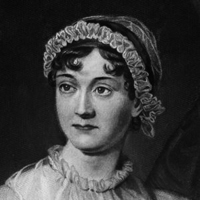Delineation of Women in Sense and Sensibility
Austen is more successful in her delineation of women than of men in her novel Sense and Sensibility. She is not only concerned with the outward consciousness of the character, but also with a psychological portrayal of the woman's character. One critic Louis Cazamian has given the view that Austin's studies of women are more searching and more lifelike than those of men.

Jane Austen
In this novel, the title moves around two female characters Elinor and Marianne. Austen strikingly portrayed these two female protagonists among others. One by representing sense and another by representing sensibility. To some extent we can say that the portrayal of these two women was the chief concern of the novelist. Elinor who is a strong representative of sense which here means, self-command, mind guided, self-discipline and a capacity to control one's emotions. For example, one such occasion occurs when Lucy Steele reveals to her the secret of her engagement to Edward. Elinor loves Edward too much and by hearing this news she can hardly keep standing. But able to keep her grief under her control, on the other hand, there is another female figure Marianne, who appears as an embodiment of sensibility which here means passionate, emotive and heart guided and disable to control one's emotion. When Willoughby deceives Marianne she becomes disable to control herself. In this way, Austen has presented two contradictory female protagonists very strikingly.
The portrayal of Elinor has been made even more convincing through the large number of passages devoted to a psychological analysis of this person. The state of mind of Elinor has been described vividly and in a realistic manner at every important stage in the progress of the story of the novel. Her reaction to Lucy's disclosure of her secret engagement to Edward; her thoughts about the exact nature of the relationship which seems to be developing between Marianne and Willoughby; her thoughts when Marianne falls critically sick; her meditations after Willoughby has told the story of his past life to her - all these and many more of her thoughts have been depicted to convey to us the inner life of Elinor, so the portrayal of this woman becomes almost the most important ingredients of the novel. Even Marianne's state of mind has been depicted at various points in the story, though in brief.
Austen portrays female characters with love, passion, kindness, but in contrast, males are not convincing. The portrayals of three main male characters are neither so elaborate nor so distinct and well defined. The behaviors of Willoughby, his sudden disappearance, his betrayal to Marianne all are not well described so we remain confused for his odd conduct. Marianne can kill herself for the love but Willoughby gives up her only for the sake of dowry which another girl would bring him. And Edward is also portrayed as the man who is not realistic or reasonable than Elinor. Edward's inability to express his love and share the problem with his loved one is not convincing either. We also feel that Lucy has been delineated more cunningly and realistically than Robert. Lucy becomes able to trap Robert who is favored by his mother and is to inherit almost the entire property of his mother. Except these, the other women like Mrs. Jennings, Mrs. John Dashwood, and Mrs. Henry Dashwood has been portrayed more successfully by Austin. In this way, Austin gives convincing and striking roles to women and the women seem certainly to have acquired greater dimensions than the men. So, we can say that her delineation of women in this novel as being more perspective than that of men.
Literary Spotlight
Introduction of Sense and Sensibility
Summary of Sense and Sensibility
Domestic Realism in Sense and Sensibility
Satirical Representation of Society
Compare and Contrast of Elinor and Marianne
Antithetical Structure of Sense and Sensibility
Irony in Sense and Sensibility
Realism in Sense and Sensibility
 |
bachelorandmaster.com |